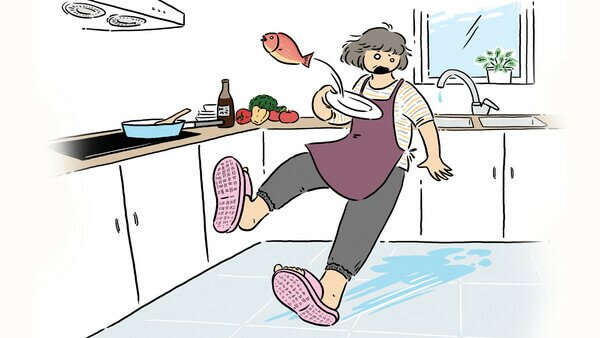Slipping and falling are common household accidents. As such, when choosing slippers, consumers should not only consider their comfort of wear, but also pay attention to their performance on slip resistance. The Consumer Council tested 30 household slippers and found their slip resistance vastly varied with an overall rating from 2 points to the highest of 5 points. The slip resistance of more than half (16) of the models on wet surfaces was far from satisfactory, including 2 models which claimed to be “slip resistant” or “anti-slip” and another model stated as bathroom slippers. Hence, to choose slippers with better slip resistance, consumers should not rely on “slip resistant” and “anti-slip” product claims, but consider the materials and tread patterns of the outsoles. In addition, consumers should keep the floor clutter-free and without water stains.On top of a pair of good slippers, consumers should also consider placing anti-slip mats and installing railings where it is needed for the elderly at home, to reduce slipping risks.
The test covered 20 plastic slippers and 10 partially plastic slippers (e.g. the uppers and the insoles were made of cloth or leather, etc.), of which 7 claimed to be “slip resistant” or “anti-slip”. Their prices vastly ranged from $10 to $520, with the cheapest ($10) model being rated overall 4.5 points, while the most expensive model ($520) only scored 3 points, reflecting that product price does not necessarily correlate to their slip resistance performance. The test items covered slip resistance on dry and wet surfaces, and a review of the materials and tread patterns on the outsoles of each model.
Sufficient friction between the outsoles of slippers and the floor surface is required to exhibit ideal anti-slip efficacy. To simulate walking on the floor with slippers, the test referenced ASTM F2913-19 and measured the Coefficient of Friction (CoF) between the outsole (forepart and heel), and the 4 types of tiles and flooring commonly used at home, namely quarry clay tiles, ceramic tiles, wooden floors and vinyl floors. The higher the CoF, the better the slip resistance.
Currently, there is no international safety requirement set for the slip resistance of household slippers. The test made reference to the slip resistance requirements set by the shoe industry on general footwear, which required the CoF of the forepart and heel of the outsoles to reach 0.3 or above. On dry test surfaces, 26 models performed desirably on all 4 types of test surfaces with a CoF of 0.3 or above, but the remaining 4 models failed to reach a CoF of 0.3 on ceramic tiles, wooden floors and/or vinyl floors, and performed the worst on vinyl floors with a CoF from 0.2 to 0.29 only. Wearing these models might incur higher slipping risks.
Water on wet floor acts as a lubricant between the outsole and the floor, thus reducing the friction in between. Compared with dry test surfaces, all models obtained a significantly lower CoF on wet surfaces. Only 14 models maintained CoF of 0.3 or above on all 4 test surfaces, while the slip resistance of the remaining 16 models on wet surfaces was unsatisfactory, of which the CoF of 2 models were under 0.3 on all 4 test surfaces.
Consumers may assume plastic slippers to be relatively waterproof and non-slip, hence being more suitable for wearing in bathrooms and kitchens, where ceramic tiles are commonly laid. However, the test revealed that the slip resistance of 14 models on wet ceramic tiles were poorer with CoF ranged from 0.16 to 0.29 only, of which 3 models even under 0.2. Among these, 6 were plastic slippers, including 1 claiming to be bathroom slippers.
The CoF of 14 models on wet and slippery wooden floors and vinyl floors were below 0.3, which was far from satisfactory. Although wooden and vinyl floors are mostly found in living rooms and bedrooms, consumers should not overlook the risks of slipping when the floor is wet due to extreme humidity or accidental spilling of water.
The material, tread patterns and hardness of the outsole are key factors affecting the slip resistance of slippers. In the test, amongst the 3 models rated the highest of 5 points, 2 models claiming to be made of rubber or thermoplastic rubber obtained a higher CoF in each of the test items. 3 models with granular treads were found to have a better grip on dry surfaces. On the contrary, 2 models with shallow striped treads on the outsoles had weak slip resistance even on dry surfaces. When the floor is wet, treads with sufficient depth can effectively drain the water or liquid away through the edge of the outsoles. The smooth outsoles and shallow threads of 3 models may have reduced their water draining ability, and consequently underperformed in slip resistance on wet surfaces.
When purchasing and wearing slippers, consumers should pay heed to the following:
- The slip resistance of slippers may vary on surfaces of different materials. Do not solely rely on the “slip resistant” or “anti-slip” claims of the products;
- Rubber outsoles are generally heavier but with better slip resistance, while deeper and wider tread patterns enable good water drainage in wet and slippery surfaces;
- Elderly or people with weaker legs may choose slippers with an appropriate CoF;
- According to overseas studies, softer outsoles are generally better in slip resistance, and offer better comfort. Nevertheless, it is easier to lose balance when walking. The tread patterns on the outsoles may get deformed or disappear under pressure over time, hence reducing their slip resistance;
- Check the wear and tear of the tread patterns on the outsole regularly. Replace slippers when the lug patterns are worn flat;
- The properties (e.g. elasticity) of the plastic materials of slippers may change under high temperatures or prolonged exposure to sunlight, thus affecting their slip resistance.
Download the article (Chinese only): https://ccchoice.org/541hs
Consumer Council reserves all its right (including copyright) in respect of CHOICE magazine and Online CHOICE.



